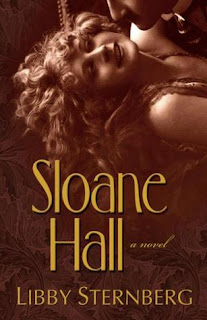
Judith‘s review of Sloane Hall
In 1920s Hollywood, young John Doyle learns the craft of cinematography when a stupid mistake costs him his job. On a tip, he heads to Sloane Hall, the estate of a famous silent screen actress, Pauline Sloane, where he lands a position as chauffeur. Sloane Hall first offers him peace as he enjoys the bounty of the luxurious home, then unrest as its beautiful namesake returns and starts preparing for her first talking picture. Despite his best efforts to resist, John falls hopelessly in love with his employer. His future brightens, however, when she appears to return his affection, leading to plans for a secret wedding—until other awful secrets intrude, leading to heartbreak and separation. A story of obsession and forgiveness, Libby Sternberg’s Sloane Hall was inspired by Charlotte Bronte’s Jane Eyre.
This is a fascinating historical full-length novel that is set in mid-1929 and beyond, during the transition between the silent film era and the “talkies.” The main character, John Doyle, is a young man who has weathered a very difficult childhood, complete with parental abuse from which he extricated himself and his mother by beating his step-father to death and being sent to Canfield, a juvenile detention facility. This story is told in the first person so has biographical flavor. And throughout the narrative, John retreats from the daily grind of his life by reflecting on the experiences he had at Canfield, remembering the abuse he encountered there with the first superintendent, and then his learning and positive support he received from the second man who assumed that post. These reflections not only give him a mental “time away,” but also serve as a way of processing what is happening to him at Sloane Hall.
The other main character in this story is Pauline Sloane, stage name for a lovely but troubled movie star named Eleanor Brickman. She is popular with silent movie fans, attempting to make the transition to sound films, mercurial, beautiful, sassy, sexy, an alcoholic, troubled, and emotionally unstable. Her agent is her half-brother and is very good at what he does, but he also drinks too much and has wrapped Pauline in a web of Hollywood “spin” in order to make himself indispensible. However, Pauline (or Ellie as she asks John to call her) is drawn to John from the very first, giving him wide-eyed looks and fluttering lashes, simpering smiles and swaying hips, so that the poor guy is lost from the first. Slowly but surely they become involved sexually. John, however, can never come to peace with the fact that he is a servant and no matter how much he loves Ellie, he feels used by her. He wants to leave her employ numerous times, but can’t face living without being around her. His experiences with his alcoholic mother give him superior insight into the little lies alcoholics tell themselves and others in order to justify their drinking, and he would often simply refuse to be around her while she was drinking.
Ultimately, their personal relationship comes to a head but rather than moving forward as they both expected, Ellie’s half-brother interferes and the relationship is ruptured, seemingly for good. John leaves, broken-hearted and without a place to go, becomes a train-hopping bum, and after being beaten almost to death, arrives in Montana where he finds his mother’s cousins who take care of him and with whom he lives for nearly a year.
This is truly a Hollywood story–the flim flam of the movie industry, the parties and hard drinking and drug use, the competition between big stars, the “spin” that is woven around their joys and disasters. It is a heart-rending tale of two people who are, as Ellie often commented, ” . . . trying to be good . . .” and who are simply looking to be loved and at peace within themselves. It is a story of loss and gain, betrayal and forgiveness, kindness and cruelty. It embraces the best and the worst of the human spirit, and exposes the reader to authentic friendship, family dynamic–even the worst of families–and the artificiality of tinsle town.
Ms Sternberg has written a beautiful novel in that it is so well crafted, the narrative sufficiently descriptive to be helpful, introspective enough to give insight into John’s insecurities and triumphs, and helpful in understanding how his early experiences influence his decisions and choices. The plot is classic–struggle, achievement, conflict, and resolution. The story line begins in such a way that the reader has a full understanding of John’s roots and early experiences, his initial failures in Hollywood as an apprentice camera-man, his willingness to be a jack-of-all-trades for Ellie and her housekeeper, and his journey back from the lowest point in his life. The characters are enticing–they are each unique and I think are rather iconic as being representative of the kinds of people we all encounter, whether in such a context as Hollywood, or just Main Street, USA.
This is truly a love story, but it is Love, Rocky Road Style. It brings the reader into the bowels of the story and it did not let me go until the very end. My only criticism: I would have loved an Epilogue. But perhaps that is not in keeping with the author’s ending. In any event, it is an entertaining novel and contains much information about the realities of that era. While the author owns up to taking some liberties with the historical reality, I found that this was so limited as to be negligible. I think romance fans, especially those who enjoy the historical setting of the early 20th century, will find much to like in this novel.
I give it a rating of 4.5 out of 5.
This book is available from Five Star. You can buy it here.
You can read more from Judith at Dr. J’s Book Place.
